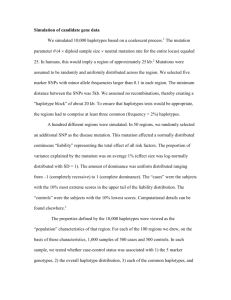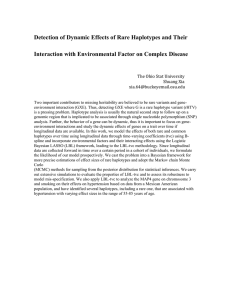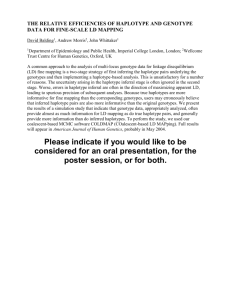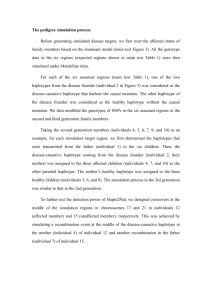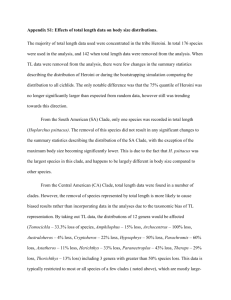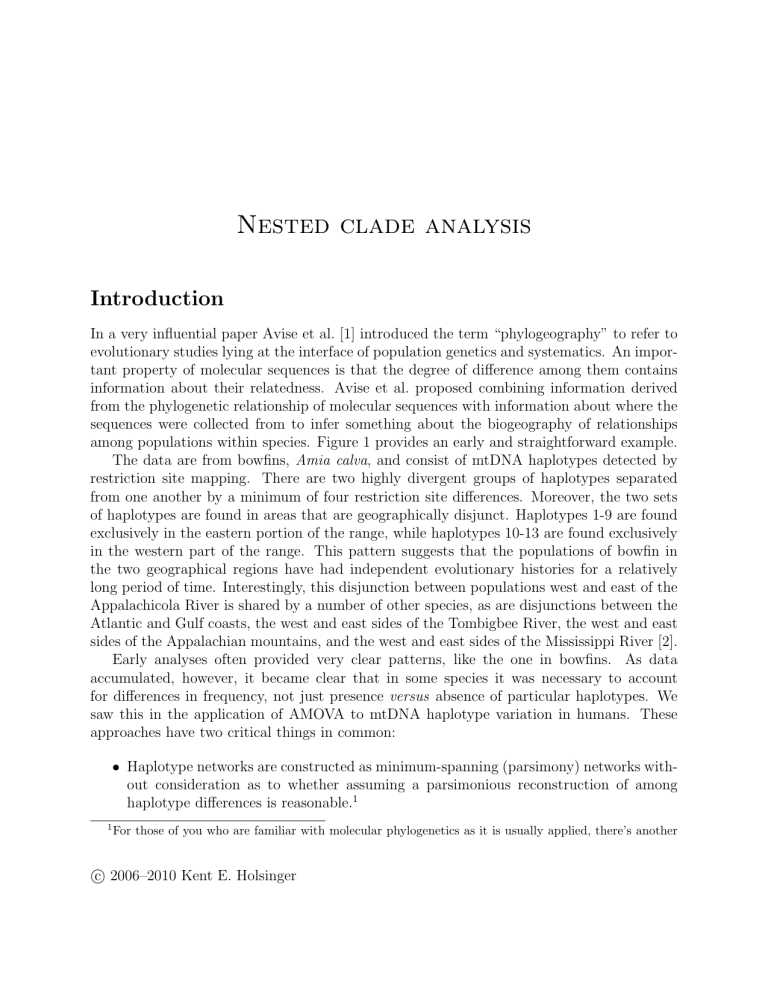
Nested clade analysis Introduction In a very influential paper Avise et al. [1] introduced the term “phylogeography” to refer to evolutionary studies lying at the interface of population genetics and systematics. An important property of molecular sequences is that the degree of difference among them contains information about their relatedness. Avise et al. proposed combining information derived from the phylogenetic relationship of molecular sequences with information about where the sequences were collected from to infer something about the biogeography of relationships among populations within species. Figure 1 provides an early and straightforward example. The data are from bowfins, Amia calva, and consist of mtDNA haplotypes detected by restriction site mapping. There are two highly divergent groups of haplotypes separated from one another by a minimum of four restriction site differences. Moreover, the two sets of haplotypes are found in areas that are geographically disjunct. Haplotypes 1-9 are found exclusively in the eastern portion of the range, while haplotypes 10-13 are found exclusively in the western part of the range. This pattern suggests that the populations of bowfin in the two geographical regions have had independent evolutionary histories for a relatively long period of time. Interestingly, this disjunction between populations west and east of the Appalachicola River is shared by a number of other species, as are disjunctions between the Atlantic and Gulf coasts, the west and east sides of the Tombigbee River, the west and east sides of the Appalachian mountains, and the west and east sides of the Mississippi River [2]. Early analyses often provided very clear patterns, like the one in bowfins. As data accumulated, however, it became clear that in some species it was necessary to account for differences in frequency, not just presence versus absence of particular haplotypes. We saw this in the application of AMOVA to mtDNA haplotype variation in humans. These approaches have two critical things in common: • Haplotype networks are constructed as minimum-spanning (parsimony) networks without consideration as to whether assuming a parsimonious reconstruction of among haplotype differences is reasonable.1 1 For those of you who are familiar with molecular phylogenetics as it is usually applied, there’s another c 2006–2010 Kent E. Holsinger Figure 1: A phylogeographic analysis of 75 bowfins, Amia calva, sampled from the southeastern United States. A. A parsimony network connecting the 13 mtDNA haplotypes identified from the sample. B. The geographical distribution of the haplotypes. • The relationship between geographical distributions and haplotypes contains information about the history of those distributions, but there is no formal way to assess different interpretations of that history. Nested-clade analysis (NCA) has become a widely used technique for phylogeographic analysis because it provides methods intended to assess each of those concerns [4].2 In broad outline the ideas are pretty simple: • Use statistical parsimony to construct a statistically supportable haplotype network. • Identify nested clades, test for an association between geography and haplotype distribution, and work through an inference key to identify the processes that could have produced the association. important difference. Not only are these parsimony networks. They are networks in which some haplotypes are regarded as ancestral to others, i.e., haplotypes appear not only at the tips of a tree, but also at the nodes. 2 It continues to produce networks in which some haplotypes are ancestral to others, but in this context, such an approach is reasonable. Ask me about it if you’re interested in why it’s reasonable. 2 As we’ll see, implementing these simple ideas poses some challenges.3 Statistical parsimony Templeton et al. [5] lay out the theory and procedures involved in statstical parsimony in great detail. As with NCA in general, the details get a little complicated. We’ll get to those complications soon enough, but again as with NCA in general the basic ideas are pretty simple: • Evaluate the limits of parsimony, i.e., the number of mutational steps that can be reliably inferred without having to worry about multiple substitutions. • Construct “the set of parsimonious and non-parsimonious cladograms that is consistent with these limits” (p. 619).4 So why use parsimony? Within species the time for substitutions to occur is relatively short. As a result, it may be reasonable to assume that we don’t have to worry about multiple substitutions having occurred, at least between those haplotypes that are the most closely related. To “identify the limits of parsimony” we first estimate θ = 4Ne µ from our data. Then we plug it into a formula that allows us to assess the probability that the difference between two randomly drawn haplotypes in our sample is the result of more than one substituion.5 If that probability is small, say less than 5%, we can connect all of the haplotypes into a parsimonious network. More likely than not, we won’t be able to connect all of the haplotypes parsimoniously, but there’s still a decent chance that we’ll be able to identify subsets of the haplotypes for which the assumption of parsimonious change is reasonable. Templeton et al. [5] suggest the following procedure to construct a haplotype network: Step 1: Estimate P1 the probability that haplotype pairs differing by a single change are the result of a single substitution. If P1 > 0.95, as is likely, connect all pairs of haplotypes that differ by a single change. There may be ambiguities in the reconstruction, including loops. Keep these in the network. 3 When we talk about statistical phylogeography, you’ll see an alternative approach to addressing the concerns NCA was intended to address, and for the final project in the course, you’ll have a chance to examine a recent debate between proponents of the different approaches and decide which you would apply to your own data. 4 Makes you wonder a little about why it’s called statistical parsimony if some of the reconstructed cladograms aren’t parsimonious, doesn’t it? 5 If you’re interested, you can find the formula for restriction site differences in equation (1), p. 620. 3 Step 2: Identify the products of recombination by inspecting the 1-step network to determine if postulating recombination between a pair of sequences can remove ambiguity identified in step 1. Step 3: Augment j by one and estimate Pj . If Pj > 0.95, join j − 1-step networks into a j-step network by connecting the two haplotypes that differ by j steps. Repeat until either all haplotypes are included in a single network or you are left with two or more non-overlapping networks. Step 4: If you have two or more networks left to connect, estimate the smallest number of non-parsimonious changes that will occur with greater than 95% probability, and connect the networks. Refer to Templeton et al. [5] for details of the calculations. Figure 2 provides an example of the kind of network that may result from this analysis. Nested clade analysis Once we have constructed the haplotype network, we’re then faced with the problem of identifying nested clades. Templeton et al. [3] propose the following algorithm to construct a unique set of nested clades: Step 1. Each haplotype in the sample comprises a 0-step clade, i.e., each copy of a particular haplotype in the sample is separated by zero evolutionary steps from other copies of the same haplotype. “Tip” haplotypes are those that are connected to only one other haplotype. “Interior” haplotypes are those that are connected to two or more haplotypes. Set j = 0 Step 2. Pick a tip haplotype that is not part of any j + 1-step network. Step 3. Identify the interior haplotype with which it is connected by j + 1 mutational steps. Step 4. Identify all tip haplotypes connected to that interior haplotype by j + 1 mutational steps. Step 5. The set of all such tip and interior haplotypes constitutes a j + 1-step clade. Step 6. If there are tip haplotypes remaining that are not part of a j + 1-step clade, return to step 2. 4 Figure 2: Statistical parsimony network for the Amy locus of Drosophila melanogaster. 5 Figure 3: Nesting of haplotypes at the Adh locus in Drosophila melanogaster. Step 7. Identify internal j-step clades that are not part of a j + 1 step clade and are separated by j + 1 steps. Step 8. Designate these clades as “terminal” and return to step 2. Step 9. Increment j by one and return to step 2. That sounds fairly complicated, but if you look at the example in Figure 3, you’ll see that it isn’t all that horrible. This algorithm produces a set of nested clades, i.e., a 1-step clade is contained within a 2-step clade, a 2-step clade is contained within a 3-step clade, and so on. One such sets of nested clades have been identified, we can calculate statistics related to the geographical distribution of each clade in the sample. Templeton et al. [6] define two statistics that are used in an inferential key (the most recent version of the key is in [4]; see Figure 4): Clade distance The average distance of each haplotype in the the particular clade from the center of its geographical distribution. “Distance” may be the great circle distance or it might be the distance measured along a presumed dispersal corridor. The clade distance for clade X is symbolized Dc (X), and it measures how far this clade has spread. 6 Figure 4: Each number corresponds to a haplotype in the sample. Haplotypes 1 and 2 are “tip” haplotypes. Haplotype 3 is an interior haplotype. The numbers in square boxes illustrate the center for each 0-step clade (a haplotype). The hexagonal “N” represents the center for the clade containing 1, 2, and 3. Numbers in ovals are the distances from the center of each collecting area to the clade center. Dc (1) = 0, Dc (2) = (3/9)(2) + (6/9)(1) = 1.33, Dc (3) = (4/12)(1.9) + (4/12)(1.9) + (4/12)(1.9) = 1.9. Dn (1) = 1.6, Dn (2) = (3/9)(1.6) + (6/9)(1.5) = 1.53, Dn (3) = (4/12)(1.6) + (4/12)(1.5) + (4/12)(2.3) = 1.8. Nested clade distance The average distance of the center of distribution for this haplotype from the center of distribution for the haplotype within which it is nested. So if clade X is nested within clade Y , we calculate Dn (X) by determinining the geographic center of clades X and clade Y and measuring the distance between those centers. Dn (X) measures how far the clade has changed position relative to the clade from which it originated. Once you’ve calculated these distances, you randomly permute the clades across sample locations. This shuffles the data randomly, keeping the number of haplotypes and the sample size per location the same as in the orignal data set. For each of these permutations, you calculate Dc (X) and Dn (X). If the observed clade distance, the observed nested clade difference, or both are significantly different from expected by chance, then you have evidence of (a) geographical expansion of the clade (if Dc (X) is greater than null expectation) or (b) a range-shift (if Dn (X) is greater than null expectation). Using these kinds of statistics, you 7 Figure 5: Geographic distribution of mtDNA haplotypes in Ambystoma tigrinum. run your data set through Templeton’s inference key to reach a conclusion. For example, applying this procedure to data from Ambystoma tigrinum (Figure 5), Templeton et al. [6] construct the scenario in Figure 6. References [1] J. C. Avise, J. Arnold, R. M. Ball, E. Bermingham, T. Lamb, J. E. Neigel, C. A. Reeb, and N. C. Saunders. Intraspecific phylogeography: the mitochondrial dna bridge between population genetics and systematics. Annual Review of Ecology & Systematics, 18:489– 522, 1987. [2] Douglas E. Soltis, Ashley B. Morris, Jason S. McLachlan, Paul S. Manos, and Pamela S. Soltis. Comparative phylogeography of unglaciated eastern north america. Molecular Ecology, 15(14):4261–4293, 2006. doi:10.1111/j.1365-294X.2006.03061.x. [3] A. R. Templeton, E. Boerwinkle, and C. F. Sing. A cladistic analysis of phenotypic associations with haplotypes inferred from restriction endonuclease mapping. i. basic theory and an analysis of alcohol dehydrogenase activity in drosophila. Genetics, 117:343– 351, 1987. [4] Alan R. Templeton. Statistical phylogeography: methods of evaluating and minimizing inference errors. Molecular Ecology, 13(4):789–809, 2004. 8 Figure 6: Inference key for Ambystoma tigrinum. [5] Alan R. Templeton, Keith A. Crandall, and Charles F. Sing. A cladistic analysis of phenotypic associations with haplotypes inferred from restriction endonuclease mapping and DNA sequence data. III. cladogram estimation. Genetics, 132(2):619–633, 1992. [6] Alan R. Templeton, Eric Routman, and Christopher A. Phillips. Separating population structure from population history: a cladistic analysis of the geographical distribution of mitochondrial DNA haplotypes in the tiger salamander, Ambystoma tigrinum. Genetics, 140(2):767–782, 1995. Creative Commons License These notes are licensed under the Creative Commons Attribution-NonCommercial-ShareAlike License. To view a copy of this license, visit http://creativecommons.org/licenses/by-nc-sa/3.0/ or send a letter to Creative Commons, 559 Nathan Abbott Way, Stanford, California 94305, USA. 9

